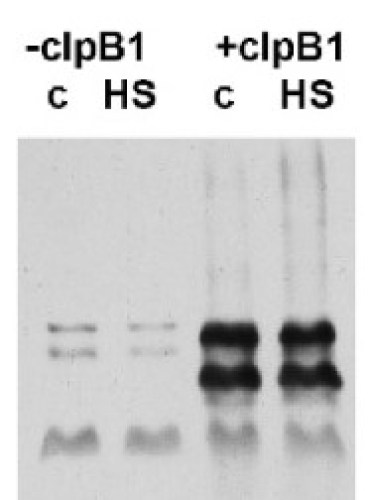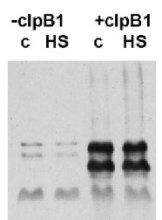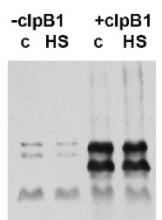
Anti-slr1641 | ATP-dependent chaperone clpB
(Cat#: AS08 344)


Description
- Immunogen: recombinant clpB1 protein, derived from Synechocystis PCC 6803 strain slr1641 sequence; protein has an internal translation site. The nomenclature used is reverse of what is mentioned in the cyanobase.
- Host: Rabbit
- Clonality: Polyclonal
- Purity: Serum
- Format: Lyophilized
- Quantity: 100 µl
- Reconstitution: For reconstitution add 100 µl of sterile water
- Storage: Store lyophilized/reconstituted at -20°C; once reconstituted make aliquots to avoid repeated freeze-thaw cycles. Please remember to spin the tubes briefly prior to opening them to avoid any losses that might occur from material adhering to the cap or sides of the tube.
- Tested applications: Western blot (WB)
- Recommended dilutions: 1 : 3000 (WB)
- Expected | apparent MW: 98.1 | 85.4 and 105 | 95 kDa for Synechocystis
- Confirmed reactivity: Synechocystis PCC 6803, Solanum lycopersicum
- Not reactive in: Chlamydomonas reinhardtii
- ClpB protein is essential for resistance to high temperature stress. It functions to dissolve inactive protein aggregates that accumulate at high temperatures. Giese and Vierling (2002) Changes in oligomerization are essential for the chaperone activity of a small heat shock protein in vivo and in vitro. J Biol Chem; 277(48): 46310-8.
- Gonzalez-Esquer and Vermaas (2013). ClpB1 overproduction in Synechocystis sp. strain PCC 6803 increases tolerance to rapid heat shock. Appl Environ Microbiol. 2013 Oct;79(20):6220-7. doi: 10.1128/AEM.01661-13. Epub 2013 Aug 2.
Boca Scientific is your premiere source for high-quality, innovative solutions for Cell Biology, Molecular Biology, Immunology, genetics and other lab products and reagents. We bring leading-edge products from our own-line and around the world to laboratories in the US and Canada. Our goal is to offer excellent solutions to drive research and discoveries backed by superior customer support.
